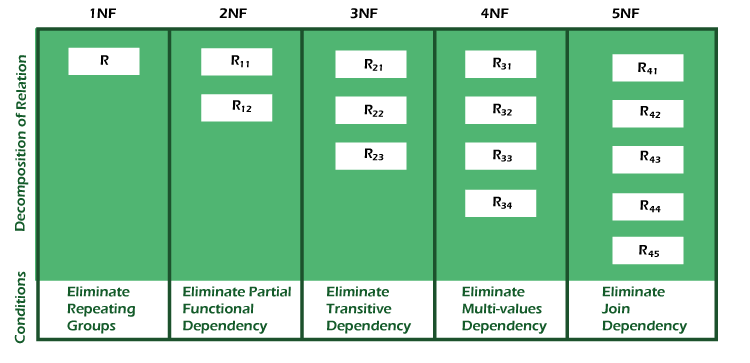Boyce Codd normal form (BCNF)
- BCNF is the advance version of 3NF. It is stricter than 3NF.
- A table is in BCNF if every functional dependency X → Y, X is the super key of the table.
- For BCNF, the table should be in 3NF, and for every FD, LHS is super key.
Example: Let's assume there is a company where employees work in more than one department.
EMPLOYEE table:
| EMP_ID | EMP_COUNTRY | EMP_DEPT | DEPT_TYPE | EMP_DEPT_NO |
|---|---|---|---|---|
| 264 | India | Designing | D394 | 283 |
| 264 | India | Testing | D394 | 300 |
| 364 | UK | Stores | D283 | 232 |
| 364 | UK | Developing | D283 | 549 |
In the above table Functional dependencies are as follows:
Candidate key: {EMP-ID, EMP-DEPT}
The table is not in BCNF because neither EMP_DEPT nor EMP_ID alone are keys.
To convert the given table into BCNF, we decompose it into three tables:
EMP_COUNTRY table:
| EMP_ID | EMP_COUNTRY |
|---|---|
| 264 | India |
| 264 | India |
EMP_DEPT table:
| EMP_DEPT | DEPT_TYPE | EMP_DEPT_NO |
|---|---|---|
| Designing | D394 | 283 |
| Testing | D394 | 300 |
| Stores | D283 | 232 |
| Developing | D283 | 549 |
EMP_DEPT_MAPPING table:
| EMP_ID | EMP_DEPT |
|---|---|
| D394 | 283 |
| D394 | 300 |
| D283 | 232 |
| D283 | 549 |
Functional dependencies:
Candidate keys:
For the first table: EMP_ID
For the second table: EMP_DEPT
For the third table: {EMP_ID, EMP_DEPT}
Now, this is in BCNF because left side part of both the functional dependencies is a key.



